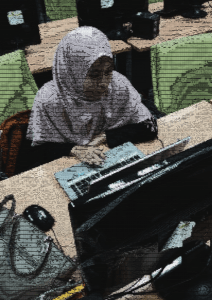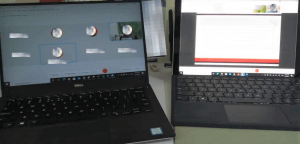Article
Presence with Absence: Anecdote on Non-Participatory Digital Participation in a Pandemic
For most people, the sense of presence is a comforting percipience. Presence embodies the value of existence, occurrence, companionship, empowerment, and transformation [1]Dufva, T., & Dufva, M. (2019). Grasping the future of the digital society. Futures, 107, 17-28.
in other words, it is about being present and feeling accompanied. In a digital world, the nuance of companionship is not limited to human communication, but rather how the human senses engage with the virtual experience provided by the digital realm.
The digital realm has always been captivating pre-Covid19. There are many findings and inventions that serves as testament to the driving growth in education, enterprises, trade, entertainment, and warfare (amongst others). The hype has always been about making things better, faster, more precise, more targeted, more opportunities, more accessibility, and more everything. The mushrooming of digital providers and the embracing of digital innovation by diverse industries are viewed as building a progressive and future ready civilization with high point-to-point connection a measure of success [2]Antonizzi, J., & Smuts, H. (2020, April). The characteristics of digital entrepreneurship and digital transformation: A systematic literature review. In Conference on e-Business, e-Services and … Continue reading
.
A human’s interest to an object is triggered and sustained by multi-sensory reception. The more sensory is engaged, the more drawn a human becomes – a key concept in the uses and gratification theory [3]Gogan, I. C. W., Zhang, Z., & Matemba, E. D. (2018). Impacts of gratifications on consumers’ emotions and continuance use intention: An empirical study of Weibo in … Continue reading [4]Johnson, P. R. (2014). Toward a Uses and Gratification’s Model of Twitter. Theses. Syracuse University. The adoption and adaption of the digital realm augments one’s sense of comfort as it elicits the sense of control and emotion within a cognitive-behavioural process.
The digital realm is mostly designed for visual and auditory consumption as the main interaction goal is connection and information consumption – a comfort activity easily conformed with sight and auditory sensory. The ding of an update or a message pop-up are some indicators of social presence via digital means. The ability to turn on digital medias for music, movies, games and more, allows a sense of personalised entertainment. Small start-ups can evolve into business empires without the need for constant travelling – just a click of video conferencing or internet calls, and a deal can be brokered. Such wonderful concoction of experience driven with sight and hearing as the human user sits at their desks, comfortably tapping away on the keyboards for more sensory fulfilment, controlling their manoeuvre in ensuring that desires and needs are satisfied.
To put things into perspective, in pre-Covid19, many humans are acquainted with the digital realm and enjoyed participating in digital interaction (Abd Manan, 2021). It is quite a commonplace to see humans glued to their digital devices, conveniently and deliberately isolating themselves [5]Baharin, H. (2021). Collective Behaviour in the Time of Pandemic: Living Alone in Digital Dwelling from physical environment for more digital presence.
So, perhaps, the Covid19 pandemic taking place where human-digital connection is a norm, (and was initially) a silver lining. The lockdown exercise (of which at the time of writing is still being executed by many countries) has resulted in humans being cut off from their community members, unable to go to work or school, shop in physical stores or do things in physical environments like they normally do [6]Abdul Shukor (2021), S. F. (2021). Comfort Amidst Chaos. Despite the circumstances, humans can execute their required tasks and obligations thanks to the digital infrastructure in place [7]Pandey, N., & Pal, A. (2020). Impact of digital surge during Covid-19 pandemic: A viewpoint on research and practice. International Journal of Information Management, 55, 102171. , manifesting itself as a system disruptor (Abd Manan, 2021). Tools that were commonly used by industries are now used by learning institutions and children. Learning is done digitally bringing a whole new notion of home-schooling. Online shopping has seen an extreme growth during Covid19. Listening to music or movie binging is facilitated by many media platforms. Most importantly, humans who are by default social animals could keep in touch with family, friends and even engage in conversations with strangers through social media and other digital communication tools. In a simplistic view, the digital realm has helped sustain the notion of presence. By participating digitally, humans can make themselves present and feel the presence of others. Sensory wise, humans are engaged.
Covid19 was, and still is terrifying. The ability to stay at home promotes a sense of comfort and control where one can safeguard oneself from becoming another Covid19 dataset. It also requires a big adjustment as one transitions from the traditional / conservative way of making business to a new method. They needed to bite the bullet whether ready or not [8]Iivari, N., Sharma, S., & Ventä-Olkkonen, L. (2020). Digital transformation of everyday life–How COVID-19 pandemic transformed the basic education of the young generation and why information … Continue reading . Hence, it is in this situation that we see a new pandemic rising – the domineering of digital presence which is largely unwanted and non-participatory.
In the excuse of managing the pandemic especially during lockdown, humans are constantly summoned to engage digitally.
Reasons are spewed in the pretext of deadlines, time clashes, and daytime internet traffic overload with unsensible calls for meetings at night, weekends, or even holidays. With cruel assumptions that one tends to relax at home, irrational workloads are given to students and workers. As conferences, trainings, webinars, competitions, information are made accessible online (and free), there is a sudden push for humans to forage and consume as much information, certification, and recognition possible. It is no longer peculiar to see a human with multiple devices turned on, with screens showing meetings, webinars and online classes taking place at the same time. It has become a race where one is measured by how much you can log on digitally – event and time wise. The supposed digital convenience is bombarding humans from every corner, resulting in sensory overload, and slowly turning the human incapacitated – mentally and emotionally [9]Liu, H., Liu, W., Yoganathan, V., & Osburg, V. S. (2021). COVID-19 information overload and generation Z’s social media discontinuance intention during the pandemic … Continue reading.
If a theme can be seen from this writing so far, it is, the notion to engage with the digital realm before Covid19 was voluntarily – the humans were happy to do so. Unfortunately, it has now become cumbersome and dreadful as they are ordained to do so. The element of digital participatory democracy is slowly being erased. Humans are scrambling for means to minimise discomfort in digital presence as without a proper intervention, the human’s wellbeing can be compromised [10]Ibrahim, N. (2021). Comfort Behaviour of Occupants during the Pandemic Time.
For a successful technology acceptance and adoption, the field of Human Computer Interaction stresses on the importance of user experience and well-being [11]Hornbæk, K., & Hertzum, M. (2017). Technology acceptance and user experience: A review of the experiential component in HCI. ACM Transactions on Computer-Human Interaction (TOCHI), 24(5), … Continue reading. Bitterly, in current context, the notion is turning into a propaganda or metaphorical at best as there is a lack of will to understand the core concept underlying those terms. There is a need to recognize that when a human is digitally wired, they are exercising their sensory reception which is mostly sight and audibles, while deskbound. It is a democratic process, only if it is voluntarily. During lockdown, humans are visually exposed with blue light emitting from the screen and information “mess”, and acoustically, humans are subjected to unwanted or prolonged sounds [12]Ibrahim, N. (2021). Comfort Behaviour of Occupants during the Pandemic Time. We are condemned with non-stop, undesirable visuals and audio input while in confinement. It is digital torture! Other sensory are deprived of input as being bounded digitally means not able to be with nature [13]Abdul Shukor (2021), S. F. (2021). Comfort Amidst Chaos – smelling the fresh air, feeling the gust of the wind, or feeling the presence of real people in a casual manner – the feeling of sensations that make humans human, is fading.
How do you fight this digital pandemic when engaging in the first place was never a choice? Humans are subjected to participate despite inadequate home conditions [14]Abdul Shukor (2021), S. F. (2021). Comfort Amidst Chaos and increased amount of energy use [15]Nohuddin, P. N. E. (2021). Behaviour Analytics on Energy Consumptions. . Calling for a mutiny may mean loss of job or lagging in education and at this time of age, one just cannot afford to raise a revolt. We have become apathic to the needs of others and can easily spit words such as “if they can, why can’t you?”. And when one is driven up the wall, they are labelled as poor self-managers.
Undeniably, the technology race pre Covid19 was, in reality, a race to deliver human’s insatiable need for technology wonders. Now, chained to constantly be digitally present imposes a human to a magnitude of sensory and they need to shut some out for their own sanity (Mheidly, Fares & Fares, 2020). The digital sensory intrusion is a pandemic calling for humans to abridge digital presence where less is more.
Humans’ need for presence is unique. Some humans are content being isolated as it allows self-healing. Some humans are fear the lack of company hence, seeks as much digital connection as possible to remain sane [16]Ibrahim, N. (2021). Comfort Behaviour of Occupants during the Pandemic Time. With the pandemic however, it is a tricky struggle in getting a sense of balance as humans try to compose sensory of self-preservation. You and I are some of those humans.
Switching on for digital sensory reception allows oneself to be present in the digital realm.
However, switching off from it remains a challenge for many of us. In our race to ensure the job gets done, that the powers that be know we exist, we neglect to switch off. We soldier on, depriving our well-being in this never-ending race of digital presence. The digital realm has indeed allowed us to get things going during the pandemic but liberating oneself to switch off is now a pressing issue, often dismissed and the cure obscure.
Can we now begin the fight against this “digital presence pandemic”?
We need to.
A present mind needs presence evanescence.
References[+]
| ↑1 | Dufva, T., & Dufva, M. (2019). Grasping the future of the digital society. Futures, 107, 17-28. |
|---|---|
| ↑2 | Antonizzi, J., & Smuts, H. (2020, April). The characteristics of digital entrepreneurship and digital transformation: A systematic literature review. In Conference on e-Business, e-Services and e-Society (pp. 239-251). Springer, Cham. |
| ↑3 | Gogan, I. C. W., Zhang, Z., & Matemba, E. D. (2018). Impacts of gratifications on consumers’ emotions and continuance use intention: An empirical study of Weibo in China. Sustainability, 10(9), 3162. |
| ↑4 | Johnson, P. R. (2014). Toward a Uses and Gratification’s Model of Twitter. Theses. Syracuse University |
| ↑5 | Baharin, H. (2021). Collective Behaviour in the Time of Pandemic: Living Alone in Digital Dwelling |
| ↑6 | Abdul Shukor (2021), S. F. (2021). Comfort Amidst Chaos |
| ↑7 | Pandey, N., & Pal, A. (2020). Impact of digital surge during Covid-19 pandemic: A viewpoint on research and practice. International Journal of Information Management, 55, 102171. |
| ↑8 | Iivari, N., Sharma, S., & Ventä-Olkkonen, L. (2020). Digital transformation of everyday life–How COVID-19 pandemic transformed the basic education of the young generation and why information management research should care?. International Journal of Information Management, 55, 102183. |
| ↑9 | Liu, H., Liu, W., Yoganathan, V., & Osburg, V. S. (2021). COVID-19 information overload and generation Z’s social media discontinuance intention during the pandemic lockdown’. Technological Forecasting and Social Change, 166 (C). |
| ↑10 | Ibrahim, N. (2021). Comfort Behaviour of Occupants during the Pandemic Time |
| ↑11 | Hornbæk, K., & Hertzum, M. (2017). Technology acceptance and user experience: A review of the experiential component in HCI. ACM Transactions on Computer-Human Interaction (TOCHI), 24(5), 1-30. |
| ↑12 | Ibrahim, N. (2021). Comfort Behaviour of Occupants during the Pandemic Time |
| ↑13 | Abdul Shukor (2021), S. F. (2021). Comfort Amidst Chaos |
| ↑14 | Abdul Shukor (2021), S. F. (2021). Comfort Amidst Chaos |
| ↑15 | Nohuddin, P. N. E. (2021). Behaviour Analytics on Energy Consumptions. |
| ↑16 | Ibrahim, N. (2021). Comfort Behaviour of Occupants during the Pandemic Time |
Images used in this articles
Other Articles
Collective Behaviour in the Time of Pandemic: Living Alone in Digital Dwelling by Nasir Baharuddin PreText The Covid-19 pandemic has caused many people to live in an ambiguous norm situation. People today are either searching to recover or are found to be recorded with uncertainty, while fitting the new norm of living amidst the pandemic […]
COMFORT (and the lack of it) FOR THE URBAN POOR DURING PANDEMIC by Nazrita Ibrahim On the 25th of January 2020, the first case of COVID-19 was detected in Malaysia by three Chinese nationals who have been in close contact with a positive COVID-19 patient in Singapore [1]“[Breaking] 3 coronavirus cases confirmed in Johor Baru,” […]
Presence with Absence: Anecdote on Non-Participatory Digital Participation in a Pandemic by Afdallyna Harun For most people, the sense of presence is a comforting percipience. Presence embodies the value of existence, occurrence, companionship, empowerment, and transformation [1]Dufva, T., & Dufva, M. (2019). Grasping the future of the digital society. Futures, 107, 17-28. in other words, it is […]
Behavior Analytics on Energy Consumptions by Puteri NE Nohuddin Space and behaviour are deemed to have a significant impact on how humans interact with their surroundings. Due to this, the Movement of Restriction Order (MCO) during the COVID-19 pandemic has ignite a great deal of public outrage and grievances. As a consequence, it has affected […]
COVID-19 as a Biopolitics?: Between Digital Contagions & Social Complexity by Mohd Shahrudin Abd Manan Monologue: Is COVID-19 simply about a biological pandemic? Or is it more than that: did COVID-19 turn out to be a Black Swan that disrupts our very fundamental societal structure? If that is the case, shall COVID-19 be treated as […]
COMFORT AMIDST CHAOS by Dr. Shureen Faris Abdul. Shukor Imagine sharing 650 square feet of living space with twelve other family members of three generations during a nationwide lockdown due to a pandemic. A single unit flat on the 11th floor of a 17-story housing block occupying a total of 2380 units. At any given […]
Collective Behaviour in the Time of Pandemic: Living Alone in Digital Dwelling by Hanif Baharin Introduction At the time of writing, Malaysia is in its third lockdown (also known as Movement Control Order 3.0 or MCO 3.0), to control the Covid-19 pandemic. A study conducted in April 2020 by Dr. Shureen Faris, shows that the […]











